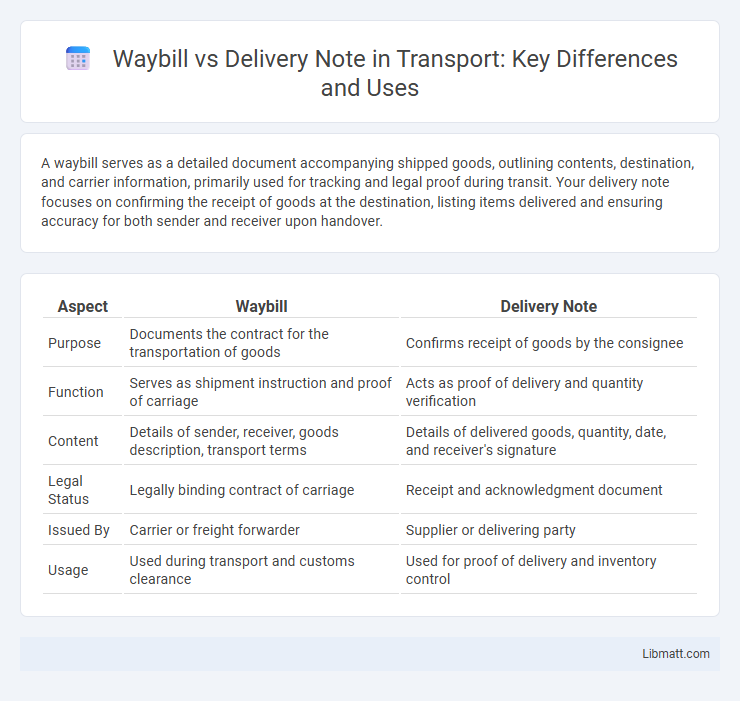A waybill serves as a detailed document accompanying shipped goods, outlining contents, destination, and carrier information, primarily used for tracking and legal proof during transit. Your delivery note focuses on confirming the receipt of goods at the destination, listing items delivered and ensuring accuracy for both sender and receiver upon handover.
Table of Comparison
| Aspect | Waybill | Delivery Note |
|---|---|---|
| Purpose | Documents the contract for the transportation of goods | Confirms receipt of goods by the consignee |
| Function | Serves as shipment instruction and proof of carriage | Acts as proof of delivery and quantity verification |
| Content | Details of sender, receiver, goods description, transport terms | Details of delivered goods, quantity, date, and receiver's signature |
| Legal Status | Legally binding contract of carriage | Receipt and acknowledgment document |
| Issued By | Carrier or freight forwarder | Supplier or delivering party |
| Usage | Used during transport and customs clearance | Used for proof of delivery and inventory control |
Introduction to Waybill and Delivery Note
A waybill serves as a detailed document tracking the shipment and handling of goods during transport, ensuring accurate delivery records for carriers and recipients. A delivery note functions as proof of receipt, listing items delivered to confirm that Your order matches the shipment. Both documents play crucial roles in supply chain management by facilitating transparency and accountability from dispatch to delivery.
Definition of Waybill
A waybill is a detailed transport document issued by a carrier that specifies the shipment's contents, origin, destination, and consignee information, enabling tracking and legal proof of transit. It serves as a non-negotiable receipt between the shipper and carrier, outlining freight details without transferring ownership of the goods. Unlike a delivery note, which confirms receipt of goods by the consignee, a waybill primarily facilitates shipment management and transportation logistics.
Definition of Delivery Note
A delivery note is a detailed document accompanying shipped goods, listing items delivered to confirm accuracy and completeness upon receipt. It serves as proof of delivery and facilitates inventory management by recording quantities and descriptions of the products. You can use a delivery note to verify that the received items match your order before signing off on the shipment.
Key Differences Between Waybill and Delivery Note
A waybill serves as a detailed document outlining the transportation contract and shipping instructions, including the shipment's origin, destination, consignor, and consignee details, while a delivery note primarily functions as a proof of receipt provided to the customer confirming the goods delivered. Waybills typically accompany the shipment and facilitate carrier and customs processing, whereas delivery notes are used at the point of delivery for verification and acknowledgment by the receiver. The key difference lies in the waybill's legal and logistical role in the supply chain versus the delivery note's operational role in confirming order fulfillment.
Purpose and Function of a Waybill
A waybill serves as a crucial document in the logistics chain, detailing the shipment's contents, origin, and destination to ensure accurate tracking and handling during transit. It functions as both a receipt for the consignor and a contract of carriage, providing essential information for carriers to deliver goods efficiently. Your ability to monitor shipments and resolve disputes hinges on the clarity and accuracy of the waybill's information.
Purpose and Function of a Delivery Note
A delivery note serves as a documented proof confirming the items delivered, ensuring the recipient can verify the shipment's contents against the supplier's records. It facilitates inventory management by listing products, quantities, and descriptions, helping prevent disputes or errors during receipt. Unlike a waybill, which primarily tracks transportation logistics, a delivery note is focused on the accuracy and acknowledgment of goods delivered to the end customer.
Legal Importance of Waybill vs Delivery Note
The legal importance of a waybill lies in its role as a contract of carriage, detailing the terms under which goods are transported and serving as evidence in disputes between the shipper and carrier. A delivery note primarily functions as proof of receipt, confirming that the goods were delivered to the consignee but typically lacks contractual or legal weight beyond acknowledgment. Understanding these distinctions helps ensure your documentation aligns with legal requirements during the shipping and delivery process.
Information Included in a Waybill
A waybill includes detailed shipment information such as sender and receiver names, addresses, contact details, package description, weight, dimensions, and tracking numbers. It also contains transportation details like carrier name, vehicle number, route, and delivery instructions, ensuring accurate logistics management. Your shipment's status and proof of delivery are often recorded on the waybill for accountability and tracking purposes.
Information Included in a Delivery Note
A delivery note includes detailed information such as the sender and receiver details, item descriptions, quantities, and delivery date. It often contains a reference number, purchase order number, and space for recipient signature upon receipt. This document serves as proof of delivery and helps verify that the correct items and quantities were received.
Choosing the Right Document for Your Business
Choosing the right document between a waybill and a delivery note depends on your business's shipping and record-keeping needs. A waybill provides detailed shipment information, including carrier data and tracking details, essential for logistics management and tracking consignments. A delivery note focuses on confirming receipt of goods, making it crucial for inventory control and customer verification upon delivery.
waybill vs delivery note Infographic

 libmatt.com
libmatt.com